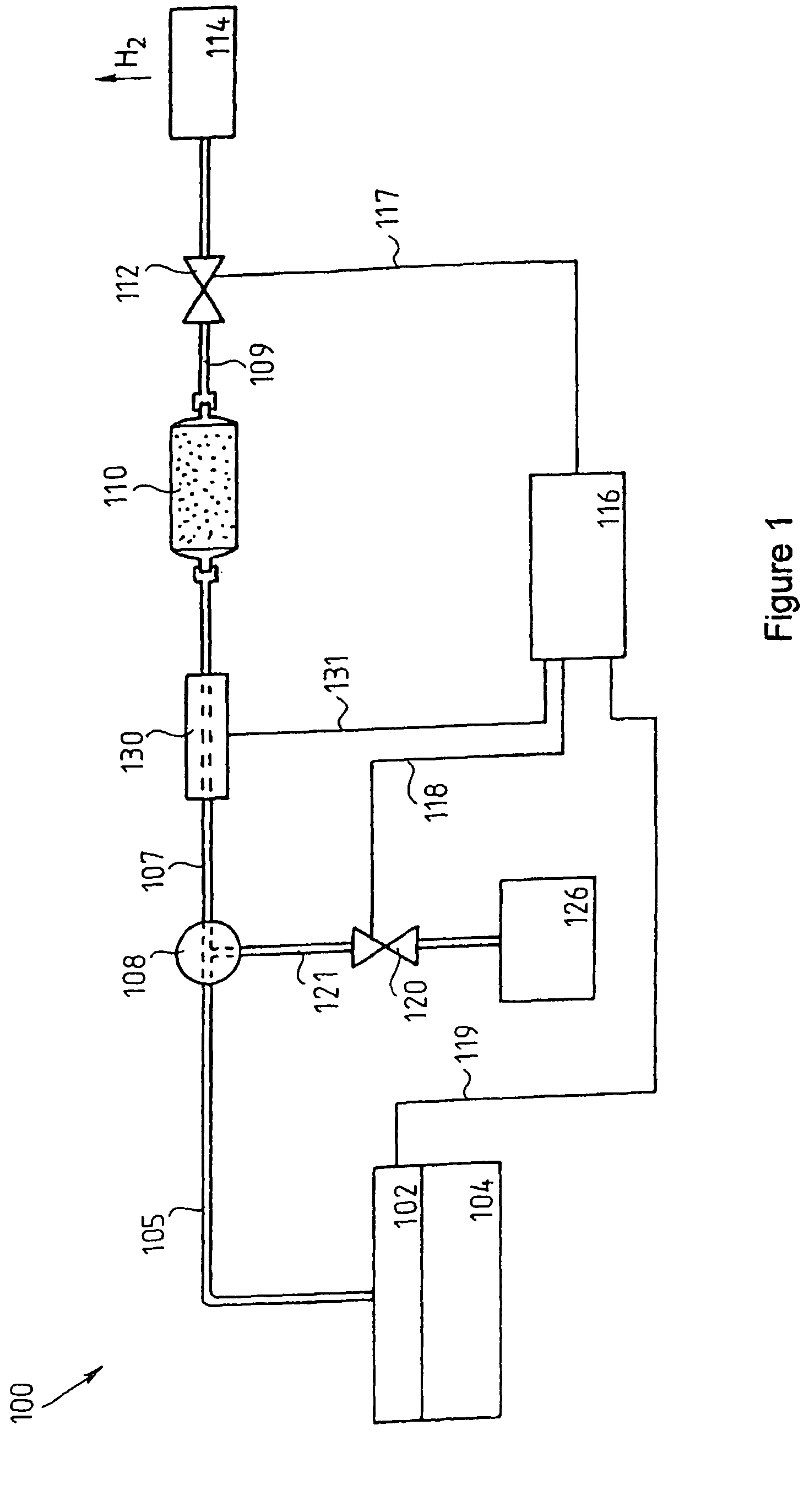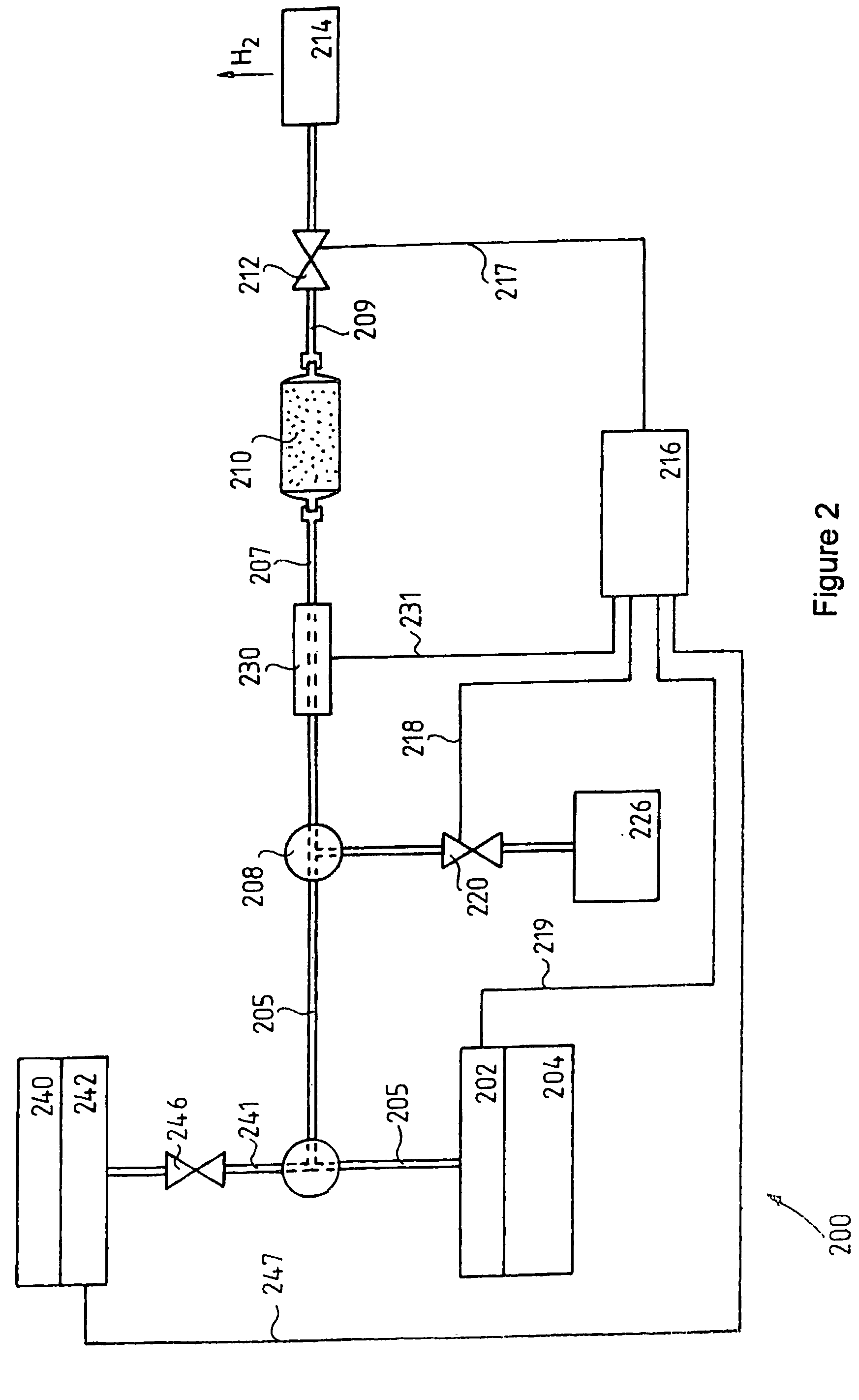Flow-type laboratory hydrogenation apparatus and laboratory hydrogenation process using the apparatus
a laboratory hydrogenation and flow-type technology, applied in the direction of gas-gas reaction process, furnace, instruments, etc., can solve the problems of increasing the dimensions and operational risk of the apparatus, requiring the use of structural elements, and relativly fast and automated synthesis/derivatisation, etc., to achieve fast and automated
- Summary
- Abstract
- Description
- Claims
- Application Information
AI Technical Summary
Benefits of technology
Problems solved by technology
Method used
Image
Examples
example 1
[0067]
[0068]To reduce a given model compound (5-nitroindol) in accordance with the above reaction scheme (to 5-aminoindol), the reservoir 104 of the hydrogenation apparatus 100 according to the invention was filled with, as a sample solution, a stock solution of a 1:1 mixture of EtOAc:EtOH containing 5-nitroindol in a concentration of 0.05 mol / dm3. At the same time, a catalyst of 10% by weight bone black palladium (Pd) or Raney nickel was arranged within the reactor 110 as the catalyst packing. After this, a flow rate of 0.1 ml / s was set within the apparatus by means of the feed pump 102, while a pressure of 30 bar was generated in the flow path by means of the pressure-adjusting unit 112. During the operation of the apparatus these values were continuously maintained. The produced hydrogenate, i.e. the 5-aminoindol was collected in the product receptacle 114, and then was subjected to an analytical assay (HPLC UV, λ=254 nm). As a result of the analysis, we concluded that the collec...
example 2
[0070]
[0071]To debenzylate a given model compound (cBz-tryptamine) in accordance with the above reaction scheme (to 3-ethyl-aminoindol), the reservoir 104 of the hydrogenation apparatus 100 according to the invention was filled with, as a sample solution, a stock solution of a 1:1 mixture of EtOAc:EtOH containing cBz-tryptamine in a concentration of 0.05 mol / dm3. At the same time, a catalyst of 10% by weight bone black palladium was arranged within the reactor 110 as the catalyst packing. After this, a flow rate of 0.1 ml / s was set within the apparatus by means of the feed pump 102, while a pressure of 30 bar was generated in the flow path by means of the pressure-adjusting unit 112. During the operation of the apparatus these values were continuously maintained. The produced hydrogenate, i.e. the 3-ethyl-aminoindol was collected in the product receptacle 114, and then was subjected to an analytical assay (HPLC UV, λ=254 nm; mass spectroscopy). As a result of the analysis, we conclu...
example 3
[0073]
[0074]To debenzylate a given model compound (N-benzyl-phenethylamine) in accordance with the above reaction scheme (into phenethylamine), the reservoir 104 of the hydrogenation apparatus 100 according to the invention was filled with, as a sample solution, a stock solution of a 1:1 mixture of EtOAc:EtOH containing N-benzyl-phenethylamine in a concentration of 0.05 mol / dm3. At the same time, a catalyst of 10% by weight bone black palladium was arranged within the reactor 110 as the catalyst packing. After this, a flow rate of 0.1 ml / s was set within the apparatus by means of the feed pump 102, while a pressure of 50 bar was generated in the flow path by means of the pressure-adjusting unit 112. The temperature of the sample solution was set to 60° C. by means of the heating / cooling means 130, and during the operation of the apparatus these values were continuously maintained. The produced hydrogenate, i.e. the phenethylamine was collected in the product receptacle 114, and then...
PUM
| Property | Measurement | Unit |
|---|---|---|
| pressure | aaaaa | aaaaa |
| total inner volume | aaaaa | aaaaa |
| partial pressure | aaaaa | aaaaa |
Abstract
Description
Claims
Application Information
 Login to View More
Login to View More - R&D
- Intellectual Property
- Life Sciences
- Materials
- Tech Scout
- Unparalleled Data Quality
- Higher Quality Content
- 60% Fewer Hallucinations
Browse by: Latest US Patents, China's latest patents, Technical Efficacy Thesaurus, Application Domain, Technology Topic, Popular Technical Reports.
© 2025 PatSnap. All rights reserved.Legal|Privacy policy|Modern Slavery Act Transparency Statement|Sitemap|About US| Contact US: help@patsnap.com



